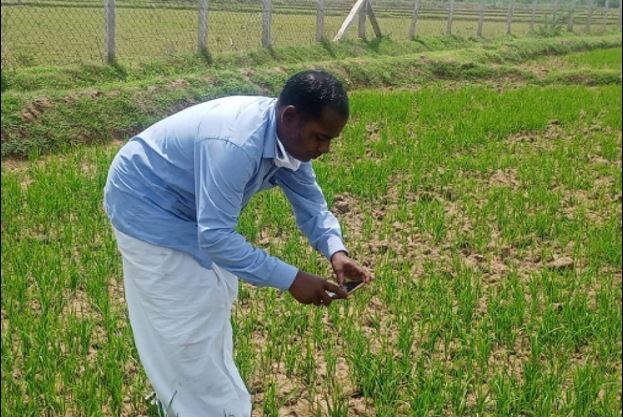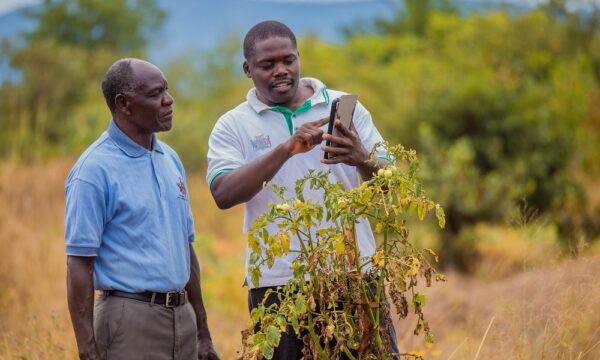
The Seeing is Believing (SIB) project started in Tamil Nadu (a southern state in India) in May 2019 in partnership with the International Food Policy Research Institute (IFPRI) and The M. S. Swaminathan Research Foundation (MSSRF), writes Akanksha Nagpal and Arun Jadhav.
The project is built upon the CABI-led Plantwise programme which aims to provide remote advice to farmers based on picture-based crop monitoring. During the third season of the project (Kharif 2020, July to October 2020), work continued in two project locations (Pudukkottai, 50 villages and Thanjavur, 20 villages) in Tamil Nadu, covering 350 farmers (19% of which were women farmers).
The farmers register their fields on a dedicated mobile app (Uzhavar Cam) and send images of affected crops (close-up images), as well as weekly repeat images of the fields, to help experts identify the growth pattern of the crop. The plant doctors, trained through the Plantwise programme, provide plant health advice to farmers through mobile messages after assessing the images received via mobile phone from farmers.
Farmers are presented with different management options based on the severity of crop damage. The remedial options sent to farmers are based on the system metadata which is created by subject matter experts. This includes the best integrated management options for each pest and disease based on the growth stage of the crop available.


The farmers appreciated both plant clinic and Picture Based Advisory (PBA) services and stated that using both the services had advantages. Plant clinics were preferred in terms of ease of access, usefulness of advisories and ease of understanding and PBA in terms of timely provision of advisories. However, due to the 2019 COVID-19 pandemic – where physical plant clinics were not possible – the farmers admitted that PBA services helped a lot.
Though virtual plant clinics were being conducted, the farmers felt that – due to network fluctuation and other technical issues – accurate diagnosis was not possible in online plant clinics. Hence, they could not realize much benefits. However, timely advisories were provided through PBA services after uploading the damage picture of the crop that saved the crop from pest and disease damage.
The PBA services helped the farmers to understand the principles behind each of the practices and how different pest management practices worked in the field. In addition, it helped to expand the institutional linkages for accessing relevant and timely plant health information beyond input dealers and changed his information-seeking behaviour to take informed decisions in pest management.
Out of the total 350 farmers, 175 farmers received a bundled service of PBA) and picture-based insurance (PBI), with insurance pay-outs based on any visible damage in the field images uploaded by the farmers.
Farmers can give the service providers ‘eyes on the ground’ by sharing pictures of their damaged crops and, thereby, augment the information available with insurance providers. This in turn will result in allowing them to provide improved financial services at a lower cost with better insurance pay-outs to farmers at low costs.
The bundling of insurance with advice increased the interest of farmers in the uptake of the service and farmers were keen to invest more in agriculture inputs due to the insurance component. The PBI elements provided additional perceived benefits for farmers, though the cost of the service needs to be further explored.
Farmers expressed that PBI was very user-friendly and the field agents collected all the necessary documents at their doorstep – making the process easy. The farmers accepted that the concept of PBI was different from other insurance schemes as it covered the economic loss due to insect pests and diseases also – which is very useful to the small and marginal farmers.
A Monitoring & Evaluation study was conducted after season 3 to understand key learnings and challenges faced by the farmers in the bundled services they obtained from Plantwise and Seeing is Believing.
The study found that 82% of farmers applied the provided picture-based advice, 76% famers admitted the advice was based on the pictures and 65% farmers adopted rational use of pesticides. However, the willingness to pay for insurance services by farmers is less than the actual premium currently required to enrol in the service.
There is also the need of a combination of products for loss assessment for the insurance pay-out – an area-yield insurance index combined with images to cover localized damage.
Such a hybrid model enables to cover both abiotic and biotic risks in farming at farm scale. At present PBA is seen as an add-on to the Plantwise service, rather than a stand-alone service, in particular as it relies on plant doctors for advice provision.
One of the farmer beneficiaries said, “During pandemic situation, the remote- advisory coupled with insurance coverage under Seeing is Believing gave me confidence and satisfaction and I am willing to continue the services in the future seasons.”
Additional information
The ‘Seeing is Believing’: An innovative concept of bundling agricultural services for the benefit of smallholder farmers blog can be found here.
The complete case study on Mobile-based personalized advisory with insurance component helps in reducing agriculture risks can be found on the MSSRF website.
More details on the Picture-based Crop Insurance can be found on the IFPRI website.
Related News & Blogs
Strengthening Agricultural Advisory Services with Generative AI
The Generative Artificial Intelligence for Agriculture Advisory (GAIA) project aims to strengthen agricultural advisory services in Kenya and India. Running from 15 April to 31 December 2024, this pilot project brings together partners to leverage the…
23 September 2024




